The problem with solving the plastics problem
There’s a push to reduce plastic packaging, but that’s not going to solve the problem of greenhouse gas emissions—in fact, it might make it worse.
That’s one conclusion of a new research paper by Value Chain Management International (VCMI) and Packaging Technology and Research. The report, “Unwrapping the Arguments... Solving packaging and food waste through government/industry collaboration,” assesses policy action in terms of the goal to reduce greenhouse gas emissions.
The report states that the complexity of packaging and food value chains means implementing one-size-fits-all “hammer” policies, such as the Canadian Environmental Protection Act (CEPA), to increase the use of recyclable plastics will not reduce greenhouse gas emissions.
In an interview with Canadian Grocer, VCMI CEO Martin Gooch said hammer policies don’t work because they don’t—and can’t—address root cause. “Social activist organizations like hammer policies because they feel it shows the government is doing something,” he said. “But there’s no evidence that when there is a complex issue that hammer policies work without having unintended consequences.”
The report comes as the federal government is getting tough on plastics. For example, as part of a reform to CEPA, the Canadian government has added “plastic manufactured items” to its list of “toxic” substances on Schedule 1 of the Act. The government notes that plastic pollution is ubiquitous in the environment, and that macroplastic pollution poses an ecological hazard, including physical harm, to some animals and their habitat.
In addition, the Government of Canada plans to achieve zero plastic waste by 2030. It states that the plan “will protect wildlife and our waters, reduce greenhouse gas emissions, and create jobs.”
A key part of the plan is a ban on “harmful single-use plastic items where there is evidence that they are found in the environment, are often not recycled, and have readily available alternatives.” Based on those criteria, the government proposes to ban six items: plastic checkout bags, straws, stir sticks, six-pack rings, cutlery and foodware made from hard-to-recycle plastics.
The problem with that lies in what people will potentially use instead. “There is absolutely no consideration that the item to replace plastic utensils, for example, might actually have a higher greenhouse gas footprint than plastic, or whether they’re any more recyclable or compostable than plastic utensils could be,” said Gooch.
The report also says addressing plastics without addressing food waste will result in increased greenhouse gas emissions. “In both Canada and the U.S., the carbon emissions that result from the food loss and waste (FLW) that is landfilled are greater than plastic food packaging’s environmental footprint,” the report states. Packaging typically equates to approximately 5% of a food’s total carbon footprint. “Packaging and FLW must be viewed in tandem,” states the report.
The report provides key takeaways and recommendations to reduce greenhouse gasses and food loss and waste, including the following (among others):
- A tandem focus on food and packaging waste is needed to meet GHG emission targets.
- GHG emissions that result from food sent to landfill are greater than the GHG emissions of plastic food packaging.
- The need for negotiated agreements is particularly critical in federated countries such as Canada and the U.S., where provinces/states and municipal governments can impede efforts by having implemented conflicting regulations and misaligned systems.
- Industry must be the driving force for change, with visionary leaders committing to achieve and be accountable for bold targets, and investing in the creation of harmonious precompetitive solutions.
- Government-implemented policies, regulations, and programs need to incentivize and assist industry in addressing barriers that inhibit the establishment of circular packaging economies, without negatively impacting the FLW reduction efforts of the food industry, NGOs, and consumers.
“We need to address the ecological and environmental issues of plastic packaging and plastic, but we can’t do it at the cost of increasing food loss and waste,” said Gooch.
While the report stresses the importance of collaboration between government and industry, Gooch said the industry should take the lead. “The industry can have greater influence over creating purposeful change and lasting change than I feel the government can because they’re the experts,” said Gooch. “The governments, at their worst, are partisan. And so it’s about winning the next election. Industry needs a longer timeline than the next election.”
Click here to access the full report.

